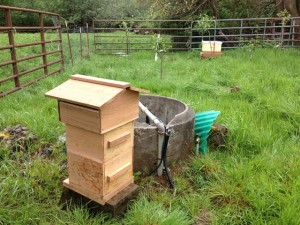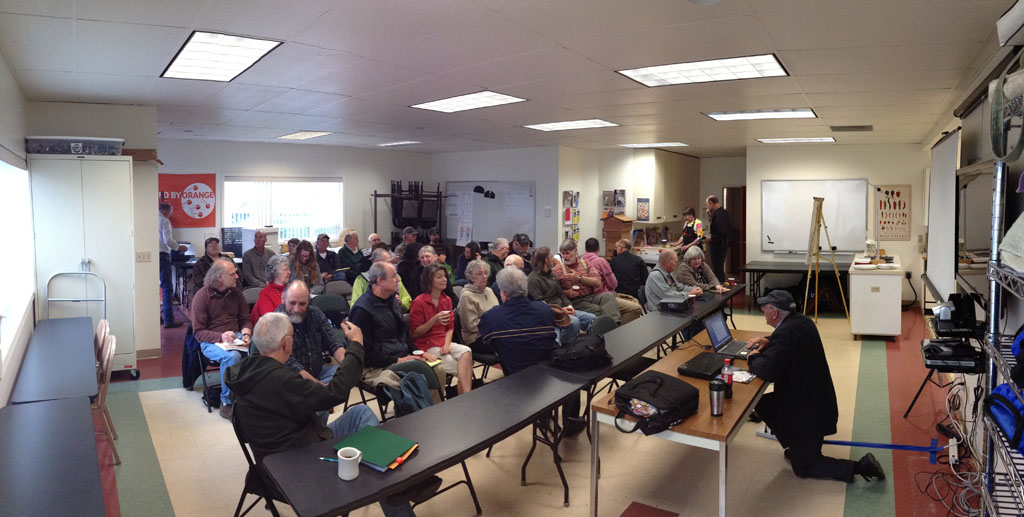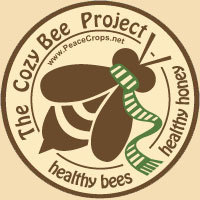Last Saturday, the local bee club put on a Bee Day class. Several of us in the club worked together to set it up- Bob coordinated it, Sheila and I did the advertising, and Trisha did the catering. The star attraction, though, was the lecturer: Dr. Dewey Carron. He’s a world-famous apicultural scientist, and has been researching and teaching about bees for over half a century. The general concensus is that we’re lucky to have him out here in Oregon; he’s originally from the east coast, and he was a professor at the University of Deleware for much of his career, and only moved out here (and subsequently joined the OSU bee lab as a retirement gig) to be closer to his grandkids.
I say “world famous” because he also lives part time in Bolivia, and literally wrote the book on Africanized (“killer”) bees. This is why I was so excited to finally meet they guy. He was the person who gave me a lot of good advice and personal connections to local Panamanian beekeepers back when I went to teach the bee class in Panama. We talked on the phone and exchanged many emails, but I never actually met the guy in person until Saturday. As I would have expected, he was a very friendly and likeable guy.
We had a turn out much larger than expected, and Dewey spoke on diverse and interesting topics. Many of the audience were already beekeepers, and we got a lot out of the day. Some of the new beekeepers may have left overloaded, though, so I am thinking about us maybe hosting a day for beginners next year. Something to think about.
As part of the display materials, many of us brought equipment for show and tell. I displayed a Warré hive I built, and it generated a lot of discussion during the breaks. Enough, that Dewey had me get up and give a 15-minute presentation on its construction, history, and how Warré management differs from traditional Langstroth hives. It was fun to get to be the “other speaker,” even if I was a little caught off guard. Afterwards, Dewey said I should lecture at the state beekeeping conference next year. That caught me more off guard, but he said he thought it was a great idea, and he’d get me on the schedule if I was interested.
 The next day, I put the hive into action. Here we see it at Lance’s farm, waiting patiently for a swarm to move in. You see, there is this thing thing that beekeepers can sometimes do called a “bait hive.” The idea is, you can leave a small, empty hive near a place you expect a swarm to pass, and with a little luck they will move into it- for free! You can’t see it in the picture, but about 30 feet away is a giant old tree with a huge crack in the base, where bees have been living for years. This is a much sought-after source of “survivor stock” genetic material. I’m not the only person who had this idea- in the background of the picture you can see Sheila and Earl’s bait hive. Sometime between when I asked Lance if I could leave mine and when I finally got around to installing it, they showed up and left theirs (we’re all friends). I was joking with Sheila at Bee Day that it would be a “duel of the hives” to see which could catch the swarm… you know, let the best hive win and all that. Really, it is a somewhat exciting experiment in apiculture. Sheila laughed, and said that she thought mine would win, and the bees would choose it because it was prettier. I’ll keep you posted.
The next day, I put the hive into action. Here we see it at Lance’s farm, waiting patiently for a swarm to move in. You see, there is this thing thing that beekeepers can sometimes do called a “bait hive.” The idea is, you can leave a small, empty hive near a place you expect a swarm to pass, and with a little luck they will move into it- for free! You can’t see it in the picture, but about 30 feet away is a giant old tree with a huge crack in the base, where bees have been living for years. This is a much sought-after source of “survivor stock” genetic material. I’m not the only person who had this idea- in the background of the picture you can see Sheila and Earl’s bait hive. Sometime between when I asked Lance if I could leave mine and when I finally got around to installing it, they showed up and left theirs (we’re all friends). I was joking with Sheila at Bee Day that it would be a “duel of the hives” to see which could catch the swarm… you know, let the best hive win and all that. Really, it is a somewhat exciting experiment in apiculture. Sheila laughed, and said that she thought mine would win, and the bees would choose it because it was prettier. I’ll keep you posted.


